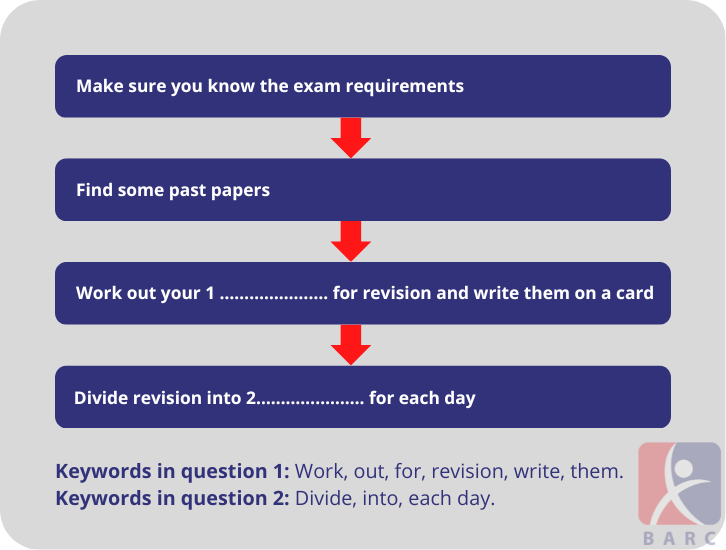Best techniques to solve flow-chart type questions in IELTS Listening
IELTS listening is one of the easiest modules in the IELTS test. The more you practice, the better score you’ll obtain in this module.
In order to develop your score Listening, having a good grasp of each type of question in IELTS Listening is of much significance.
Sometimes, one finds MCQs pretty easy. At other times, one can find flow chart completion questions insanely challenging.
That is why, in order for you to ensure a better accuracy rate, one should work on each of the question types separately. This blog presents you with the top ten hacks for solving flow-chart questions in IELTS listening.
1. Read the instructions
At the very beginning, your job is to read the instructions and make sure you confine your words to the word limit given by the instruction. Instructions tend to vary from question to question.
So, read the instructions meticulously each time you move on to the next question type. You will be given no marks for your answer for your correct answer if it exceeds the word limit specified by the instruction. So, a short but smart technique is to kick off the listening module with instructions.
2. Read the questions and underline the keywords in the questions
Before you start each of the parts in Listening, you’ll be given 30 seconds for each part which contains 10 questions. 50% of your success is reliant on how promptly you utilize that particular time prior to each of the parts in the Listening test.
When confronting MCQ, at the beginning of those 30 seconds time, you need to read through the questions and underline the keywords in the question.
This will give you a clear idea of what to look for in the audio, making it easy for you to extract the answers from the text. Look at the flowchart below.

From the example above, you can see that we can find at 6 keywords in the first question and 4 keywords in the second question. If you circle or underline them during the test, you can concentrate only on the audio as you have already got a brief version of what you have to be looking for.
3. Answers come in order in the audio
This is an interesting characteristic of this kind of question. You can always keep track of what’s behind you and what’s coming next. It also reduces the chance of losing track halfway through.
If you, however, get lost in the middle, skip the question you have missed and move on. Remember that no institutes in the world ask for 9 out of 9 in Listening. So evidently you need to correct all 40 questions. So, just follow the order of the questions.
4. Notice how the questions are paraphrased
This is very crucial to keep your prime focus on how the same words in the questions are being discussed in the audio clips in different words.
IELTS can partly be called a vocabulary game, especially in the Listening and Reading modules. The quicker you can catch the paraphrases, the higher your accuracy will be. Therefore, if you build your vocabulary, that will give you an upper hand.
5. Revise your spelling
Although you prepare well by putting in your painstaking efforts, spelling mistakes may happen out of nervousness and stress during the exam.
But what can you do is revise your spelling at the time when you will have the time to transfer the answers to the answer sheet.
You’ll often observe that you’ll come up with a few spelling mistakes—though it does not necessarily need to be conscious. So by following this technique, you can boost your accuracy rate and overall band score as well.
6. Check if the words you write fit grammatically into the sentence
In the Listening test, there are numerous gap-filling questions e.g., summary completion, and flow-chart questions. In fact, in all fill-in-the-gaps questions, you can adopt this technique.
When you are going to finalize an answer, think about the overall meaning of the sentence and consider if that particular word would be the right fit into the sentence grammatically.
7. Don’t miss out on the plural words
There is no exam where some candidates do not make mistakes regarding singular-plural words. If the speaker says the answer in singular form, you must write it in singular form, and if it comes in plural form, you must write in plural form.
Otherwise, the answer will be considered wrong, and neither will you get any mark against this answer even if it is a correct answer.
You need to be highly attentive and focused while listening to the audio so as to spot this issue. For example, you can find three different ways to pronounce ‘s’ in a sentence or word endings. If you are aware of these pronunciation rules, if would be way too easy for you to catch the correct answer in most of the cases.
8. Predict the answers
This is a core sub-skill in Listening that you cannot go without. The prediction could be made based on syntax, context, and previous sentences.
No matter how accurate you are with your assumption, it’s always integral to learn to predict answers. If you learn to do it, this will set you 50% ahead of others. So, I recommend that you apply and develop it while you practice at home.
9. Take notes while listening to the audio
There are plenty of places where you will remain blank, having more than one option in hand for a single question. In fact, it will pose a great challenge for you to choose just one of them.
What you can do is take notes while you are listening to the audio so that you are left with some background information to decide once you are indecisive about any question.
10. Keep focused
It is easier said than done. In a stressful environment like IELTS exam day, this is quite challenging to keep focused throughout the time. But it is important to retain your concentration from the beginning of the exam till the end.
You can work on prolonging your attention span if you realize that you have a tendency to lose attention in the middle. Performing prayers, yoga, and some other exercise drive up your mindfulness.
In conclusion, Listening is quite easy as long as you build yourself in a way that you will get all the traps over and go on performing. All in all, consistent practice is the key. I hope the tips discussed above will help you a great deal. Let me know which technique, you find interesting and effective.
You may also like: IELTS Listening Question Types


Pingback: IELTS Listening Question Types - British American Resource Center